Darwin & The Water Cure – Part 1 Mr. Darwin & Dr. James Manby Gully
- 18th August 2020
Did you know Charles Darwin had links to Malvern? In this three part blog we look at his visits and connections to the water cure using some of the books and information in our collections.
Much has been written about Charles Darwin and his discoveries during the HMS Beagle voyage [1831-36]. His observations of the giant tortoises, mockingbirds and marine iguanas of Galapagos; the remarkable geology of the American continents and pacific islands, and the marine life he observed and documented laid the groundwork for his ‘The Origin of Species’. Whilst his ‘Origins’ book explores the theory of evolution by ‘Natural Selection’, the word evolution itself didn’t actually appear in it at all. Also, the idea that after returning home, he published his theory straight after is another myth. It wasn’t until 1859 that Darwin, using a wealth of different lines of evidence accumulated over a 20 year period at his home in Down, Kent finally published his book.
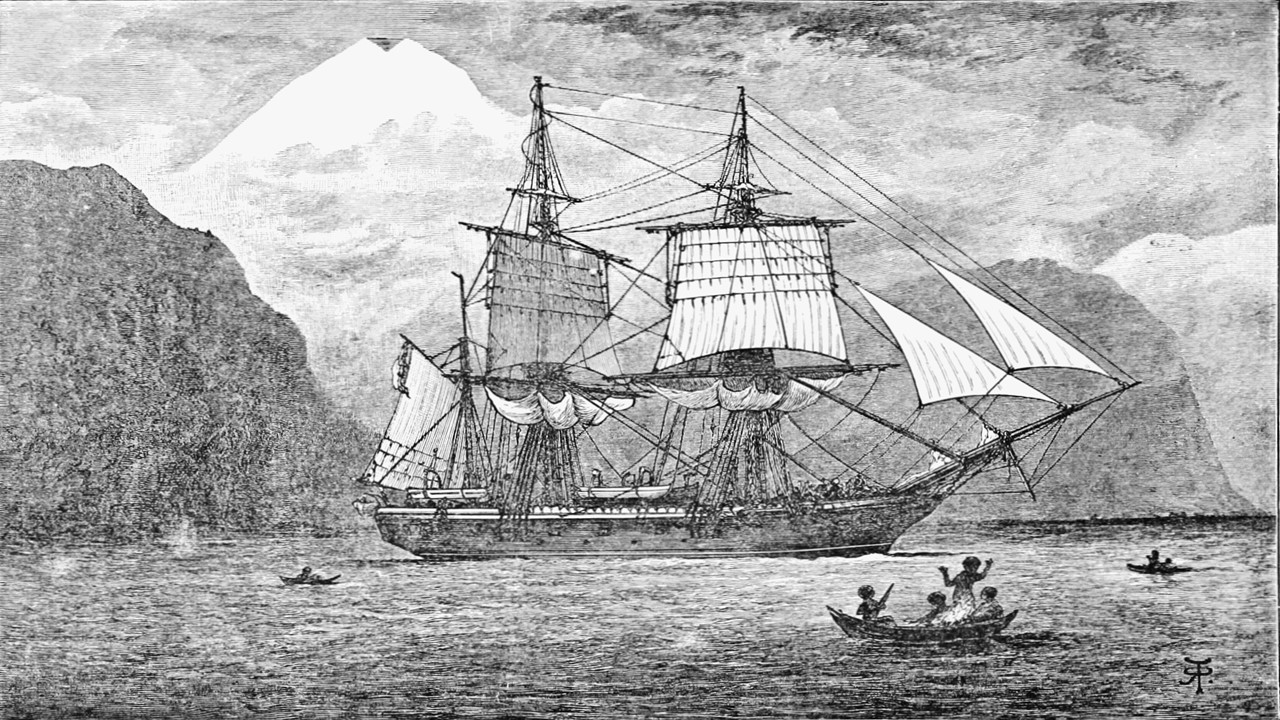
H.M.S. Beagle in the Straits of Magellan By R. T. Pritchett, reproduction of frontispiece to Murray 1st edition of Charles Darwin’s Beagle Journal of Researches. 1890
A century after his grandfather Erasmus and others such as Lamarck were debating whether species were immutable, Darwin’s ‘Natural Selection’ gave a mechanism and an answer to a fundamental question surrounding the origin of life. Darwin’s ‘Origins’ proposed that life had undergone ‘transmutation’ or change over time through adaptation to Earth’s changing environments, through sexual selection and competition. The struggle for the survival of species where only the fittest survived had led to the bewildering biodiversity that we see on Planet Earth today. However, Darwin faced personal tragedy and setbacks professionally over the long years of accumulating evidence, careful observations and experiments that could have derailed the publishing of ‘Origins’ entirely.
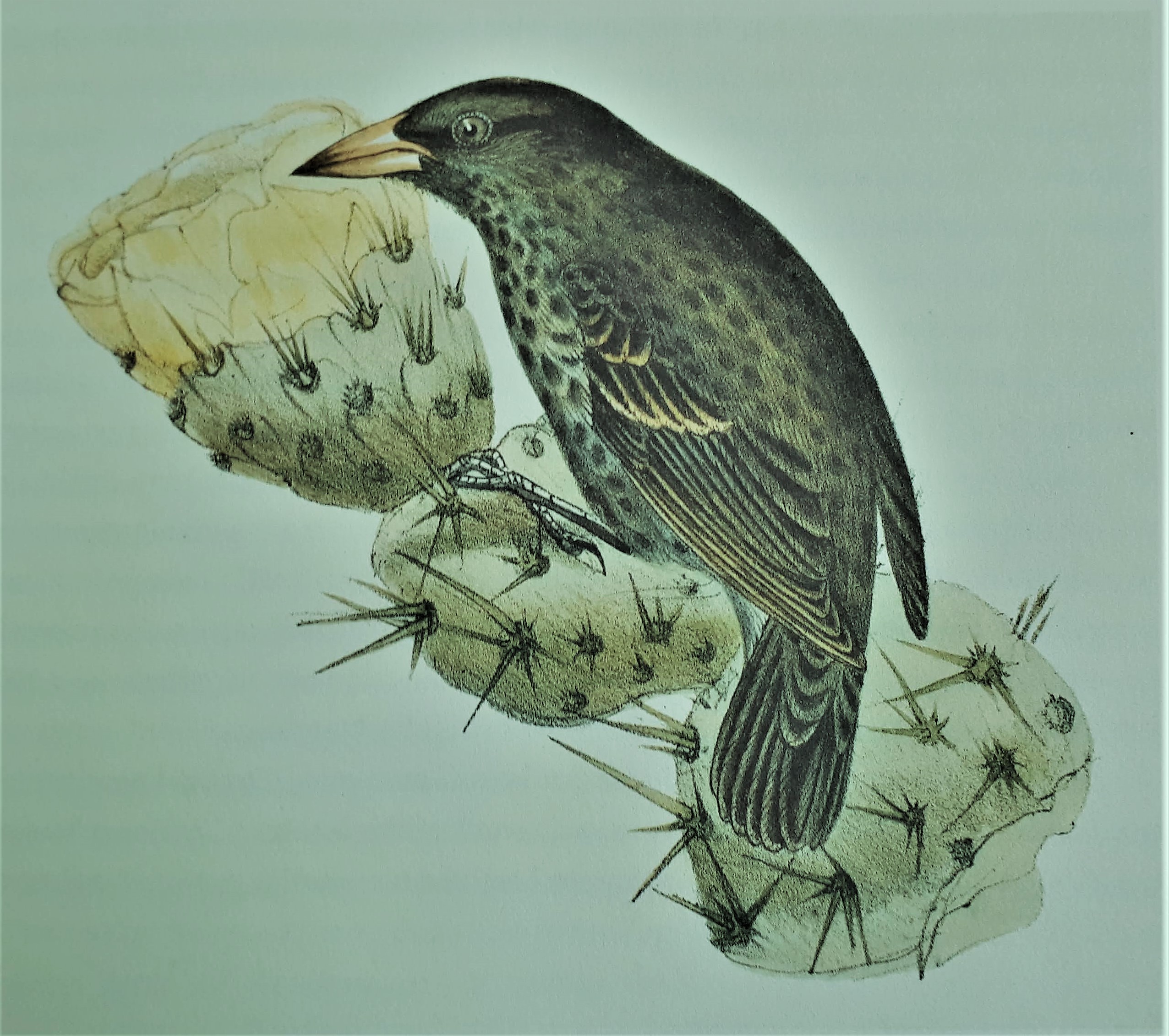
The common cactus finch Geospiza scandens in a lithograph by John and Elizabeth Gould, from The Zoology of H.M.S. Beagle 1838
Whilst at Down House, Darwin took advantage of the increasingly sophisticated postal system at the time to correspond with scientists, naturalists, friends and family writing thousands of letters (Stott, 2003). This network was key not only to his incredible scientific endeavour but ultimately would force his hand into publishing his theory. In March, 1849, a critical period in Darwin’s life, he and his family came to Malvern so that he could undergo treatment from renowned hydropathist Dr. John Gully. Thanks to an incredible archive of Darwin’s letters via The Darwin Correspondence Project, Darwin Online, our own Palfrey collection and other sources we can explore this crucial period of Darwin’s life, leading up to the publication of his theory.
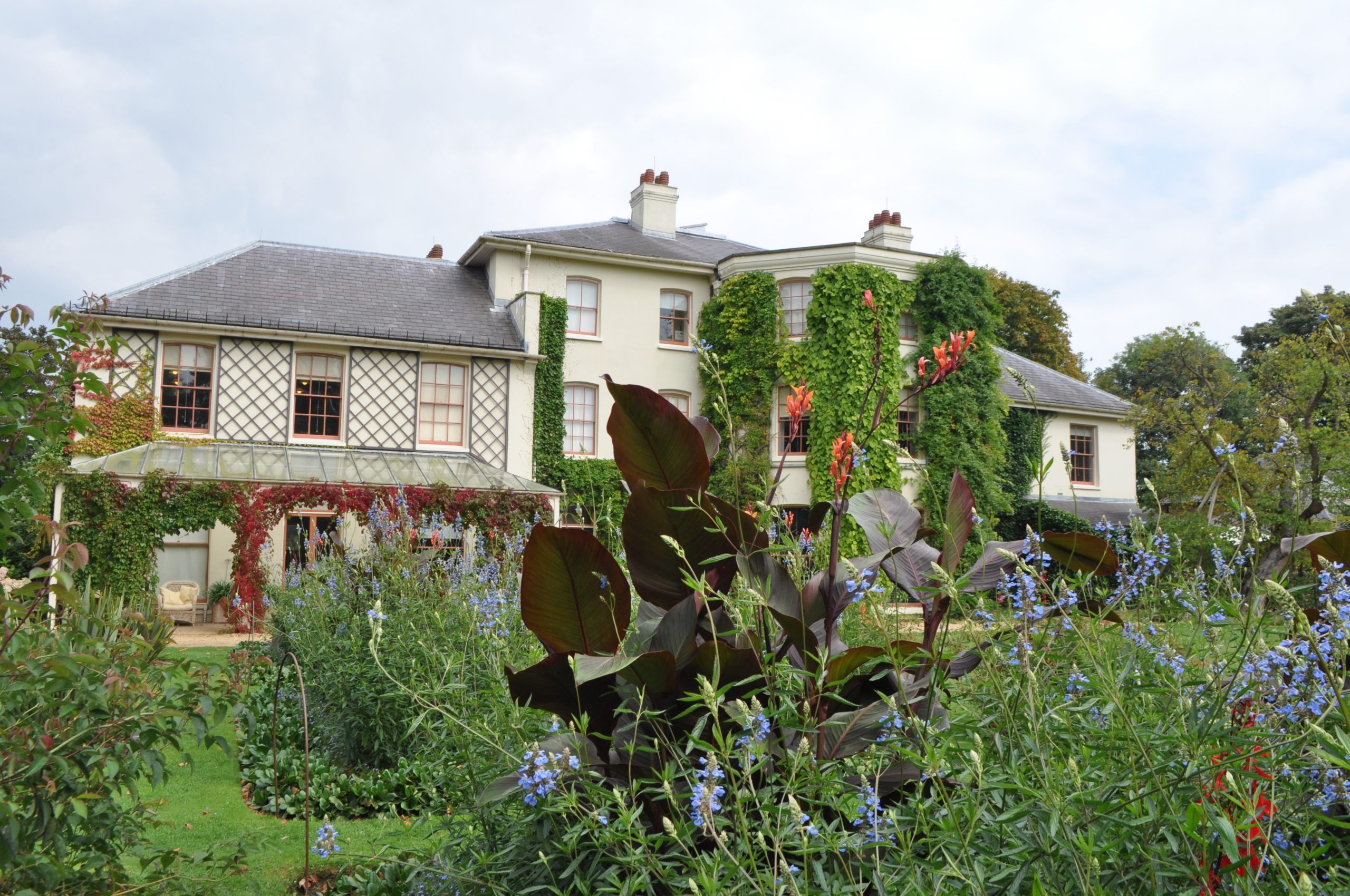
Down House, former home of Charles Darwin and his family, now run by English Heritage as a museum celebrating Darwin’s life © Anthony Roach
On 28th March, 1849 Darwin’s letter to his friend, confidante and ally, the botanist Joseph Dalton Hooker (who would later succeed his father William Jackson Hooker as Director of Kew Gardens) describes the sad death of his father Robert, his poor health and subsequent visit to Malvern to be treated by Dr. Gully. He writes:
“All this winter I have been bad enough . . . and my nervous system began to be affected, so that my hands trembled, and head was often swimming. I was not able to do anything one day out of three, and was altogether too dispirited to write to you, or to do anything but what I was compelled. I thought I was rapidly going the way of all flesh. Having heard, accidentally, of two persons who had received much benefit from the water-cure, I got Dr. Gully’s book, and made further inquiries, and at last started here, with wife, children, and all our servants. We have taken a house for two months, and have been here a fortnight. I am already a little stronger . . . Dr. Gully feels pretty sure he can do me good, which most certainly the regular doctors could not. . . . . . I feel certain that the water-cure is no quackery. How I shall enjoy getting back to Down with renovated health, if such is to be my good fortune, and resuming the beloved Barnacles.”
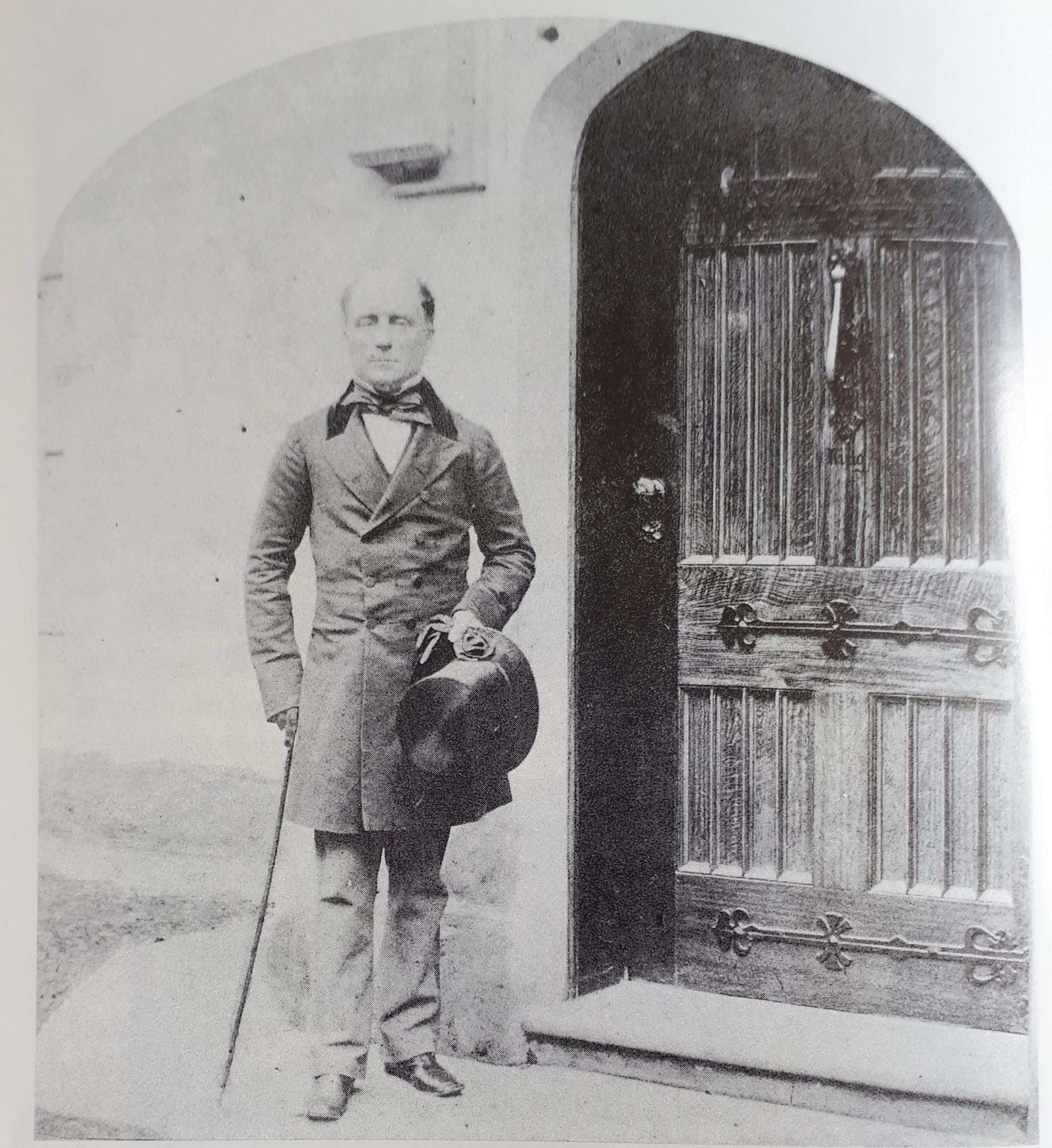
Dr. Gully, The Physician at Malvern in Randal Keynes’ Annie’s Box. Keynes, 2001
Darwin’s mysterious illness had been particularly bad in the winter of 1848-49 but he had been suffering with sickness since he and his wife Emma (his first cousin and member of the Wedgewood family) visited her parents at Maer, Staffordshire, in 1840, not far from his own family home at The Mount, Shrewsbury. Among symptoms were a state of languor and discomfort in which he could not work, swimming of the head, dying sensations and black spots before the eyes. Darwin’s illness, their son William reported ‘threw a certain air of sadness over the life at Down’ (Keynes, 2001).
In February, 1849, Darwin had turned forty and felt it was time he did something to try and turn the tide with his health. Having read Gully’s book The Water Cure in Chronic Disease, he wrote to him. None of the letters to each other survives, but Emma commented after his first reply in her letter to Darwin’s cousin W.D. Fox that he wrote ‘like a sensible man’ and did not ‘speak too confidently’. She also writes that ‘It is a great trouble taking all the household, but we think he could not give Dr Gully’s treatment a fair trial under 6 weeks or 2 months & that would be too long to leave the children even with their Aunts. We both feel very hopeful that it will be of some use to Charles tho we do not venture to hope a cure. This has been a disheartening winter with respect to his health.’
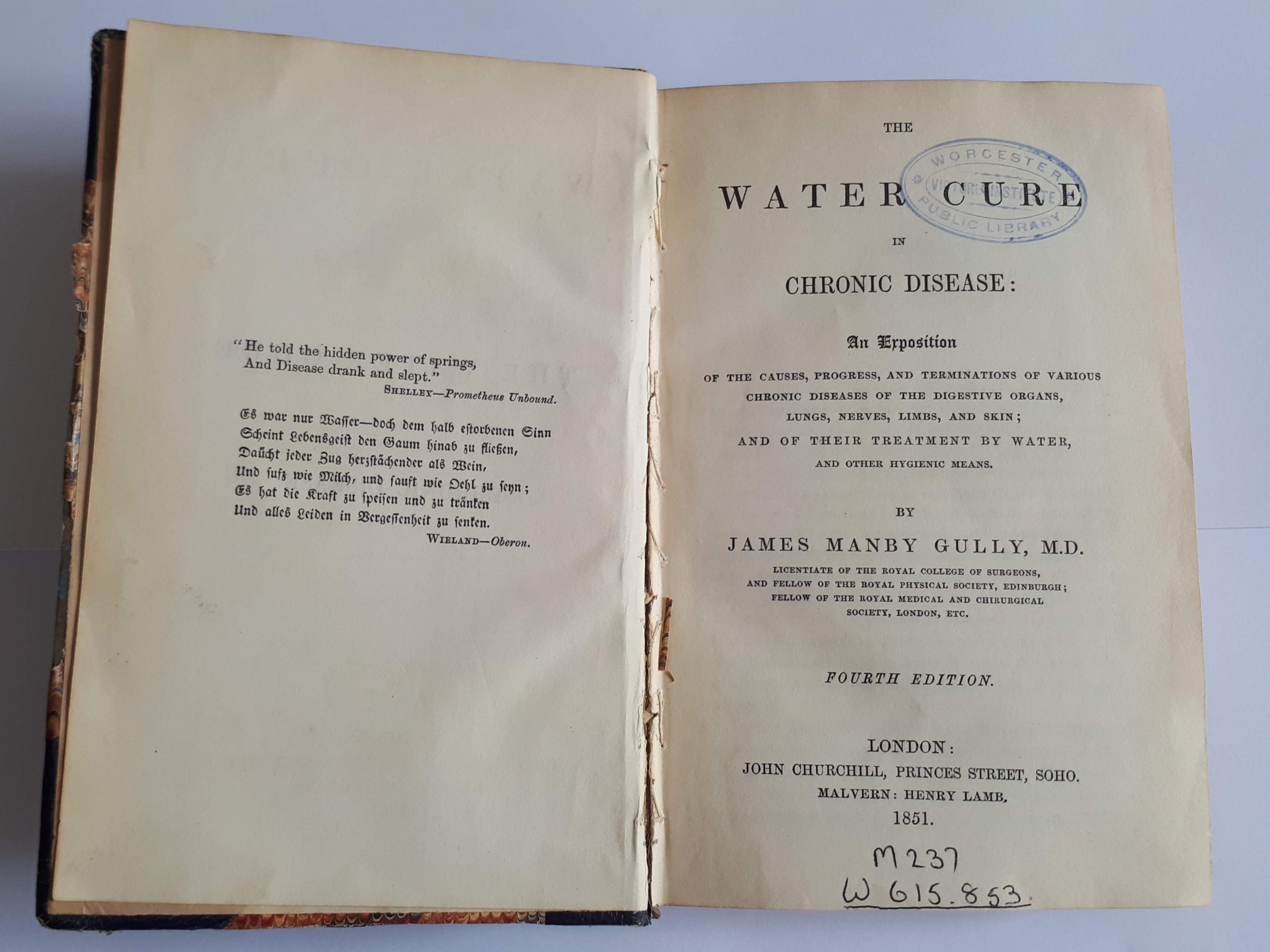
Inside cover of The Water Cure in Chronic Disease by James Manby Gully (1851) available at ref: L 615.853
Dr Gully had himself become interested in the water cure after the death of his two-year-old daughter from croup in 1840. She had been treated with ‘emetics to prolong nausea, mercury to increase salivation, endless blistering and drastic purgatives’. Watching her die in extreme pain, Gully renounced drug therapy and following a meeting with Dr James Wilson (who believed that many illnesses were simply ‘drug diseases’) they decided to partner to create ‘Water Cure’ establishments in Malvern. For more on their partnership and ‘The Water Cure’ visit our blog here.
As Keynes writes each of the two Doctors had his own theory of the workings of the human body, and their water treatment consisted of a strict diet and a range of special ways of washing and soaking different parts of the body to achieve effects on the nervous system and circulation (Keynes, 2001). Gully, also was unorthodox in including aspects of homeopathy (and mesmerism) in his treatments, something which invited Darwin’s wrath as shown in a letter to Fox in September 1850.
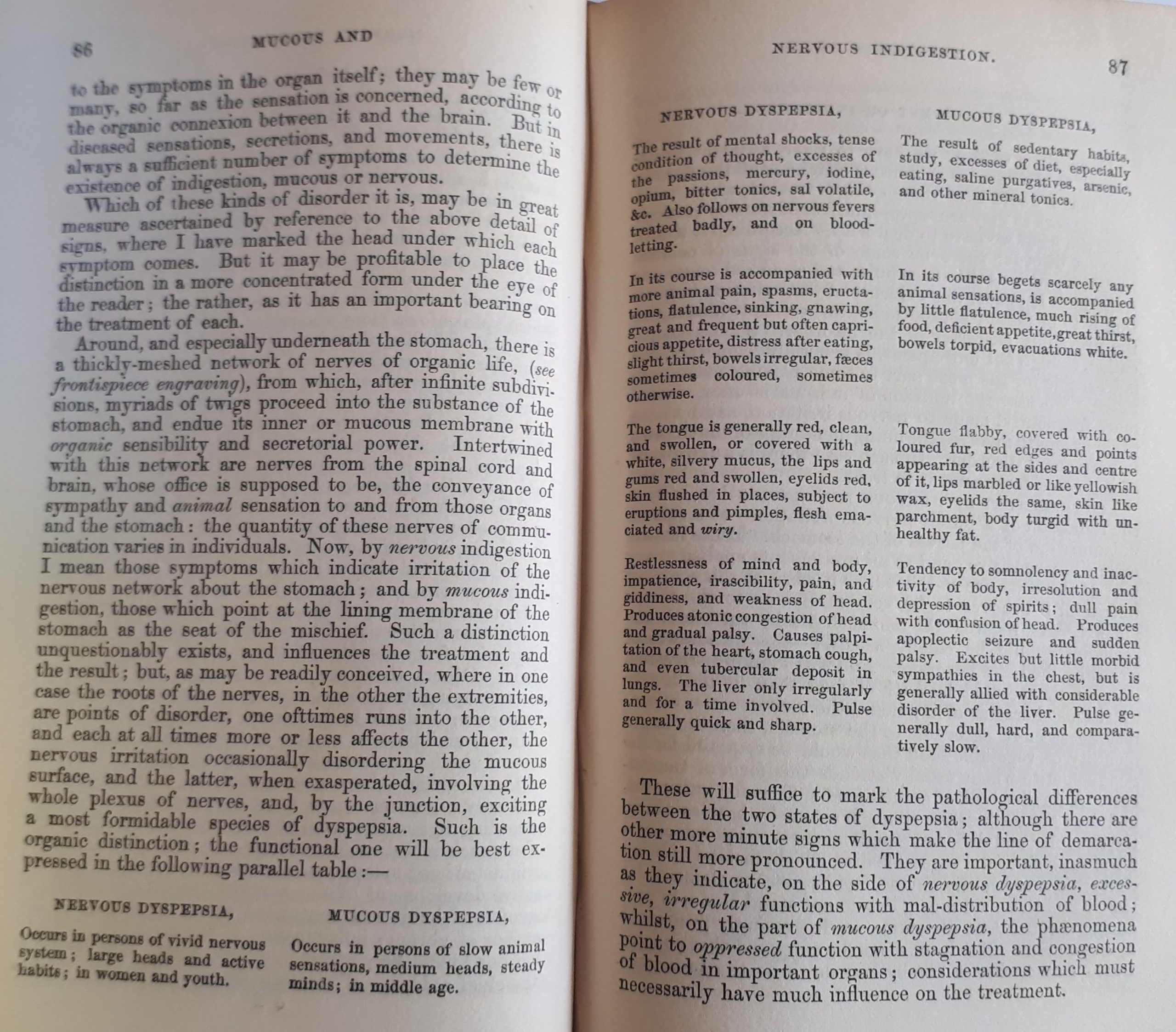
Nervous Dyspepsia described in Gully’s 4th edition of The Water Cure in Chronic Disease 1851. available at ref L 615.853
A summary of notes of Darwin’s symptoms by Darwin to physician John Chapman describe his symptoms in detail here and included: …’extreme spasmodic daily & nightly flatulence: occasional vomiting; Vomiting preceded by shivering, hysterical crying dying sensations or half-faint….singing of ears, rocking, treading on air & vision. focus & black dots. All fatigues, specially reading, brings on these Head symptoms ?? nervousness when E.[Emma] leaves me.’
Following his consultation with Dr Gully, he argued Darwin was suffering from ‘Nervous Dyspepsia’ (Nervous Indigestion), which along with many chronic diseases and ailments (from Pulmonary Consumption to Dandriff) is described in Gully’s 4th edition of The Water Cure in Chronic Disease from our reference collection at L 615.853. Darwin’s symptoms ‘indicate irritation around the nervous network of the stomach’ and ‘Occurs in persons of vivid nervous system; large heads and active habitats; in women and youth’. Darwin was indeed a large head whose nerves and over-stimulation of the mind, Gully argued were making him ill.
It was no wonder he was complaining, retching, producing sores and swellings. It was its way of saying, ‘Enough’. He suggested a course of water and other treatments to focus the body’s natural energies to heal itself (Stott, 2003). Gully had sternly explained the strictness of the water cure to him. He had to take it seriously or it won’t work its way. It meant no sugar, salt, rich foods or stimulants. No writing, no work, minimal reading – absolutely no exertions to the brain (Stott, 2003).
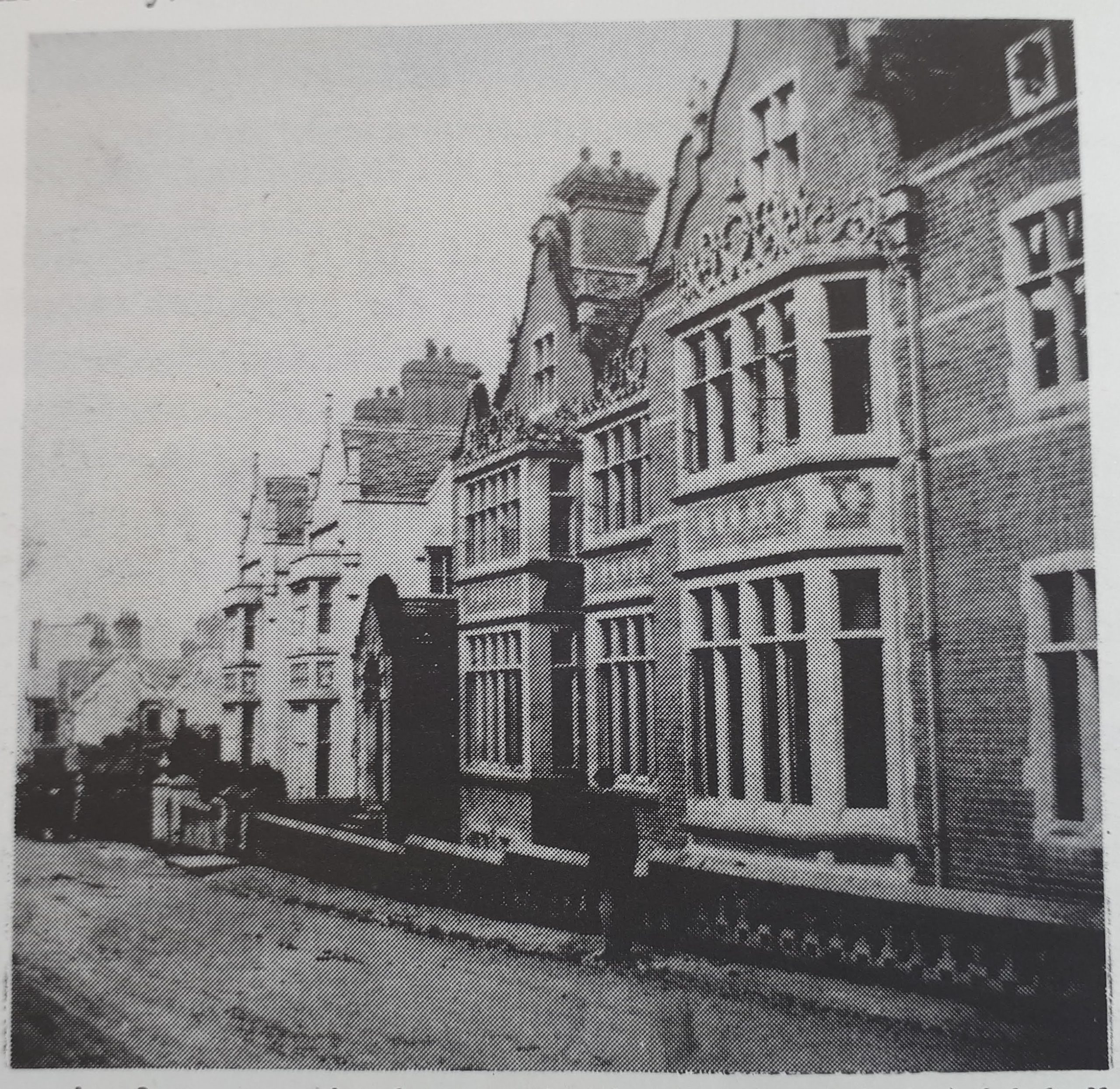
A photograph showing Dr. Gully’s Tudor House & Holyrood House in John W. Harcup’s The Malvern Water Cure 1992.
Most who were treated at Dr Gully’s water cure establishment at Holyrood House or Dr Wilson’s at Priessnitz House (for more on Wilson’s establishment see here) took up lodgings close by with their own rooms. Darwin, who wanted his family close by and privacy, took a villa known as The Lodge for the family which was almost identical to Down House – a large white stucco house built along the Worcester Road in the 1830’s and 1840’s for visitors to the spa. Charles Dickens, who like many others including Thomas Carlyle, Florence Nightingale and Alfred Tennyson came for the water treatment described his own approach to Malvern and the blue mass of the Malvern Hills in 1851 ‘growing browner and greener with every mile; the black surface of rich woods, rising from the skirts; then the long, straight row of dwellings, with their white walls shining in the sun.’ (Keynes, 2001)
Writing to his cousin W.D. Fox in his letter of 24th March he says ‘I much like & think highly of Dr. Gully. He has been very cautious in his treatment & has even, had the charity to stint me only to six pinches of snuff daily. — Cold scrubbing in morning, 2 cold feet bath & compress on stomach is as yet the only treatment, besides change of diet &c.— …to commence tomorrow a sweating process.’
In a letter to his sister Susan Darwin on 19th March he writes a detailed account of his treatment, an extract of which is shown here:
‘¼ before 7. get up, & am scrubbed with rough towel in cold water for 2 or 3 minutes, which after the few first days, made & makes me very like a lobster— I have a washerman, a very nice person, & he scrubs behind, whilst I scrub in front.— drink a tumbler of water & get my clothes on as quick as possible & walk for 20 minutes—2 I cd. walk further, but I find it tires me afterwards— I like all this very much ….I like Dr Gully much—he is certainly an able man: I have been struck with how many remarks he has made similar to those of my Father.’
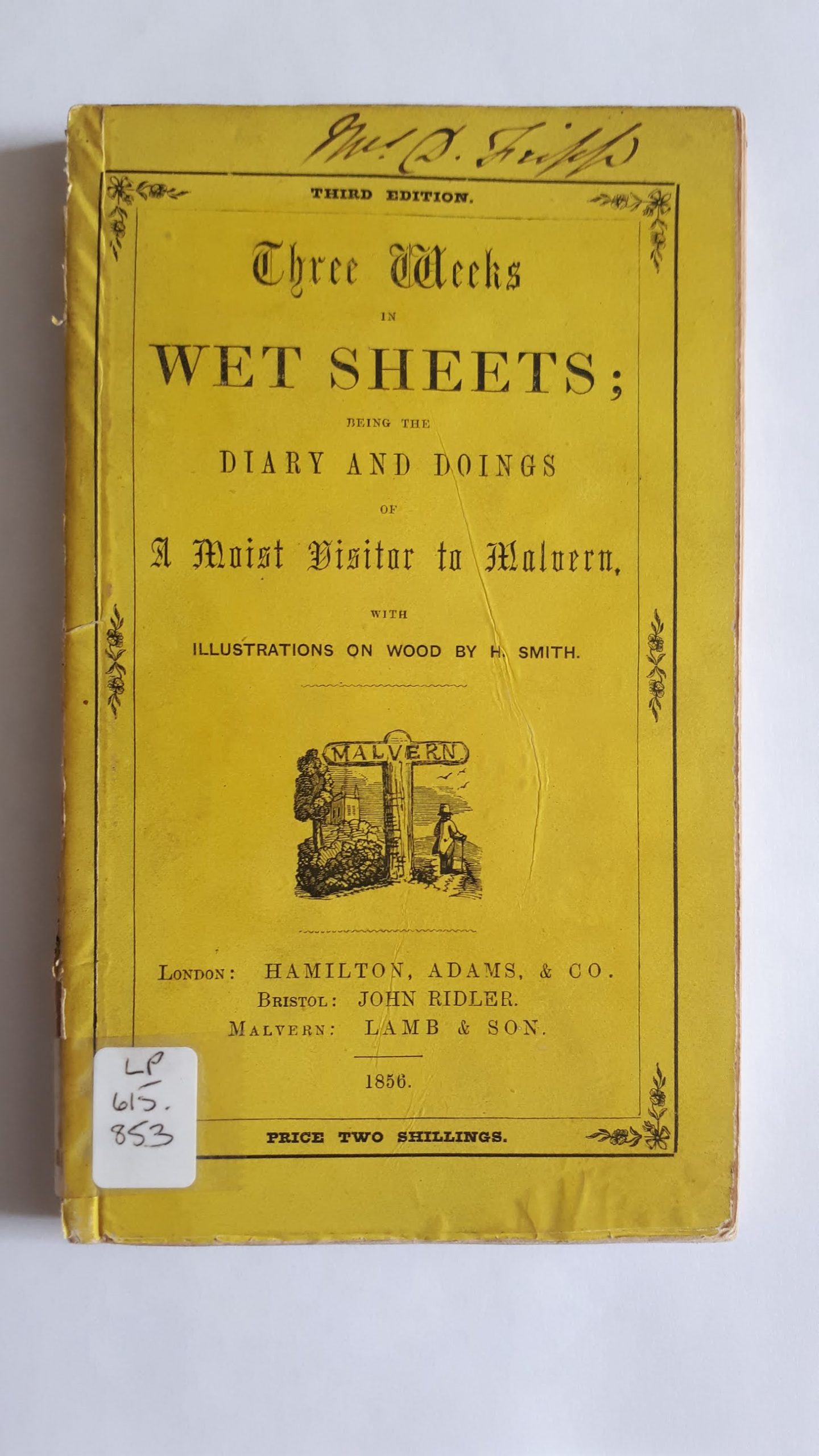
Front cover of Joseph Leech’s Three Weeks in Wet Sheets. 1856 available at LP 615.853
In both letters, he mentions several commonplace treatments as part of the cure, one includes ‘Packing’ which involved lying wrapped in wet sheets, ‘The Neptune’s Girdle’ (a cold compress worn all day on walks to and from the hills and at mealtimes), ‘The Sweating Lamp’ under a blanket and the other well-known treatment is ‘The Douche’ which was a shower of icy water from above. The journalist ‘Joseph Leech’s book ‘Three Weeks in Wet Sheets’ from our Palfrey collection at LP 615.853 describes comically the experiences of those taking the cure. Just as Darwin was invited to walk the hills with his tumblers of water, along with the other patients, Leech says
‘Anybody you meet . . .like yourself, is steaming with moisture – however gorgeous the old dowager is dressed at night, she’s in reality underneath as moist as a frog – the fair young beauty is but a water lily up to her arms in that element’…
As Darwin was invited to explore the Malvern Hills and breath in the magnificent views and invigorating air he would have encountered a hive of activity as Leech writes ‘The moment you set your foot on the summit, commerce cries and clatters around you with its importune clamour, in the shape of basket-girls pestering you to become the purchaser of ginger-beer, biscuits, and walnuts, or the owners of return donkeys tempting you with a cheap ride down again’ (Leech, 1856). Darwin’s time spent in Malvern was just beginning.
Further Information:
The Darwin Correspondence Project: https://www.darwinproject.ac.uk/
Darwin Online: http://darwin-online.org.uk/
The Water Cure in Chronic Disease
Author: James Manby Gully. 1851. – Available at Level 2: Local Lending – L 615.853
The Malvern water cure : victims for weeks in wet sheets.
Author: Harcup, John W. 1992. – Available at Level 2 Local Lending – L 615.853
Three Weeks in Wet Sheets
Author: Joseph Leech. 1856. – Available at Level 2: Palfrey Collection – 615.853
Annie’s box: Charles Darwin, his daughter and human evolution
Author: Keynes, Randal. 2001. – Available at Malvern Library, Local Reference – B DARWIN,C
Darwin and The Barnacle
Author: Stott, Rebecca. 2003 – Available at Malvern Library, Local Reference
An
Post a Comment